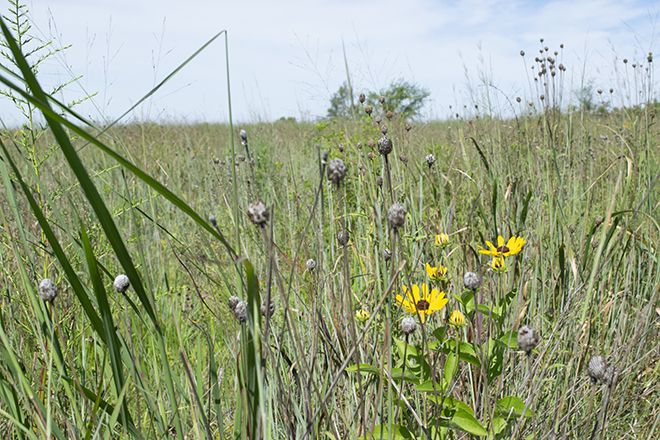By Shane Weinberg
On a cool, pre-dawn early November morning with fog floating in the valleys, I found myself sipping hot coffee by the light of my headlamp in the middle of a recently mowed and sprayed Conservation Reserve Program (CRP) field.
The anticipation built as the first glow of sunrise began to illuminate the star-filled sky. At roughly 20 minutes to sunrise I heard my first
koi-lee as coveys of bobwhite quail began to talk to each other. This moment will forever be engrained in my mind.
Not only was it my first fall covey call count but it was the first covey call count with a dedicated Quail Forever member and landowner in southern Iowa. We were standing in his recently re-enrolled CRP field, tracking the quail population and how it responds to his CRP habitat management over the next ten years.
The land is enrolled in what was Iowa’s newest CRP practice at the time, Iowa’s Early Successional Quail Habitat SAFE (State Acres for Wildlife Enhancement) aka Iowa Quail SAFE, which was available through Continuous CRP and was limited to 40,000 acres across 35 counties; mainly the three bottom tiers in Iowa.
Landowners and managers had to be quick to participate in the popular practice as the 40,000 acres were called for in almost the blink of an eye, lasting just over a month. Sitting at or close to 40,000 acres for several years, the 2018 Farm Bill switched it from a Continuous CRP practice to a General CRP practice.
This gave the practice a new home and opened the door for unlimited acres across the 35-county region as long as the land meets basic eligibility requirements and there are acres available in the national CRP acreage cap.
The Quintessential Quail Habitat
The Quail SAFE’s official conservation practice number is listed as CP38E-4D, which means it’s a “permanent wildlife habitat” practice. Iowa DNR Upland Wildlife Biologist Todd Bogenschutz states that the goal of the practice is to put the “bedroom, living room, and kitchen all withing 10 quail steps of each other.”
Approved contracts have two requirements – nesting cover and early successional habitat – and a few optional habitat components – food plots, winter cover (shrub planting or edge feathering), and firebreaks. The native shortgrass mix nesting cover and the optional habitat components make up 75 percent of the offered acres, leaving the remaining 25 percent to be planted to an innovative CRP cover type - small grains - creating early successional habitat areas (ESHAs).

Approved small grain species include but are not limited to oats, wheat, sorghum, pearl millet, and partridge pea. The ESHAs are planted in years one, four, and seven of the ten-year contracts. These small grain areas provide essential and quality brood rearing habitat by transitioning from small grain fields to beneficial annual weed fields filled with common and giant ragweed – important food sources for foraging quail in the winter months – on a three-year rotation.
The Quail SAFE practice is the prototypical habitat blueprint for quail management taken straight from the history books.
Success in the Field
“It’s not only the best practice we have ever done on the farm, it’s also the one most enjoyable and fun,” says Mark Rutledge, a Quail Forever and Pheasants Forever dual life member who has owned and managed his southern Iowa farm for wildlife since 2006.
Coming from ruffed grouse country on the east coast, Mark had an interest in upland birds and talked to older bird hunters from the area who mentioned “coveys on every fence row back in the ‘80s.”
Over the years, Mark began to mimic land uses of the 80’s by leaving areas fallow and saw positive results with the bird population on his farm. Fast forward to 2017 when the Iowa Quail SAFE was introduced as a new CRP SAFE practice. “I knew it would help enhance our bird cover even more. The early successional habitat component is what was missing from other CRP projects,” says Mark.
Mark’s Quail SAFE CRP paired with other habitat improvement projects like edge feathering have helped all wildlife on the farm. “After three years into it, the brood counts have increased nicely.”
What it means for quail in Iowa
The addition of quality nesting habitat, winter cover, and early successional habitat all bode well for the whistling bobwhite quail across their southern Iowa range. Numbers may never climb back to what they were during the “glory days” of the 1970’s and 80’s but for new and future hunters just beginning their upland hunting quest, we may be entering the “golden days” of quail hunting in Iowa thanks to favorable weather in recent years and top-notch habitat practices like CRP’s Quail SAFE.
At the time of writing this, reports from the field from landowners, land managers, and natural resources professionals have all been favorable. It’s looking to be a positive year for upland birds in southern Iowa. Over the last 5 years, the statewide quail index has hovered around the 10-year average with its highest peak in 30 years in 2016.
If you are interested or want to learn more about Iowa’s Quail SAFE, available CRP practices, or information on other habitat-oriented programs contact your local QF/PF Farm Bill Wildlife Biologist, Private Lands Biologist or NRCS representative.
Shane Weinberg is a Quail Forever Farm Bill biologist based in Iowa
This story originally appears in the Winter 2021 issue of Quail Forever Journal. To read more great quail content, become a member today!